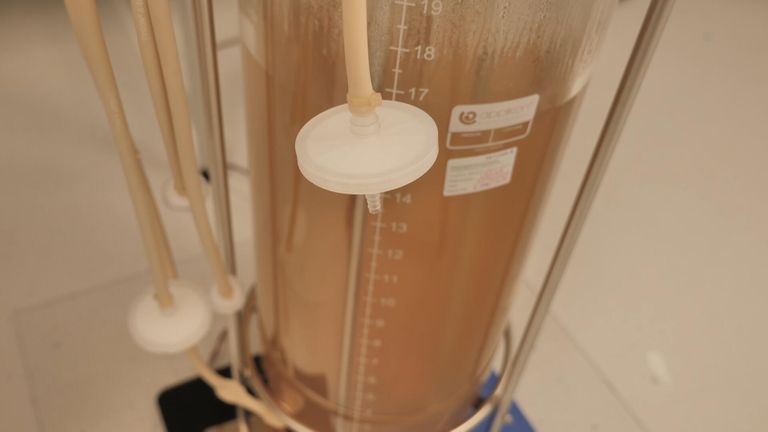Ivy Farm, on the outskirts of Oxford, is not a farm as you know it.
There is grass but it’s artificial, there are pigs and sheep but they are upholstered foot-stools with sewn-on faces. There are offices and labs where meat is grown.
This could be the future of farming.
That future could be about to take a small step closer, as the prestigious Piccadilly grocer Fortnum & Mason tests the meat in its famous scotch egg.
But the immaculate afternoon tea service will have to wait.
As we step back to the lab, and even before that, to the abattoir. Because, whether you are cultivating beef, chicken or pork, it has to start with muscle and fat cells from a very recently deceased animal.
They only need a sugar cube-sized lump of flesh and they only need it once. That will provide the root-stock cells potentially forever.
The next stage is to identify and separate the barely 3% of that tissue that contains the particular stem cells required for future growth. These cells and a very carefully researched liquid feed are then combined.
Lab-grown meat should vastly reduce land requirements and emissions
Ben Kinder, Ivy Farm’s director of manufacturing and operations, oversees these bioreactors, clear-sided glass cylinders where pale brown liquid darkens and thickens as the cells grow over a few days.
“It’s essentially a mixing tank,” he says. “In there we have some beef cells at the moment, some beef muscle, stirring around. And then we’ve got our own culture media formulation, which is the nutrition for the cells. It’s food.”
The attraction of lab-grown meat for some consumers and many investors is that it should vastly reduce the huge land requirement and punishing greenhouse gas emissions from conventional livestock farming.
‘Absolutely’ a significant moment in evolution of lab-grown meat
Back on Ivy Farm, the next stage of life isn’t being turned out into an open field but maturing in a bigger tank.
Mr Kinder says: “What comes out of the process is similar to mincemeat. So that’s the kind of texture we can incorporate into finished products. We’re not quite at the stage of fillet steaks yet. We will be there in years to come.”
That beef mincemeat has then been combined with herbs and seasoning, wrapped around a quail egg, and perfectly cooked and presented to me and Hattie Cary, Fortnum & Mason’s food and drink studio producer, on a three-tier cake stand atop a stiff cotton tablecloth.
I ask if she thinks this is a significant moment in the evolution of lab-grown meat.
“Absolutely,” she replies. “Cultivated meat is in its infancy, and we are unbelievably honoured to be able to create the first-ever cultivated meat scotch egg and be among the first people ever to taste it outside of a lab.”
It’s not approved yet by the Food Standards Agency for human consumption in the UK and, before eating, I had to sign forms saying I was aware of the “risks” and took them willingly.
But how did it taste?
It tasted very good: meaty and with the right “mouth feel”, I wouldn’t have known I was eating anything other than farm-reared meat minced and wrapped around an egg. Though, creating convincing processed meat is not the toughest of taste test challenges.
Perhaps a bigger hurdle is the “yuck” factor. Many people think meat should walk about in a field not spin around in a flask.
Fortnum & Mason are not planning to sell the cultivated meat scotch egg any time soon, not least because of government regulation. But they want to start the conversation.
“Convincing customers would certainly take a little bit of education because it’s new and it’s something that we’re not used to seeing,” Ms Cary says.
“And, at the moment, it feels like one of those very sci-fi things that people can’t quite believe is really happening.”
In an era of alarm over the volume of processed food being consumed, many people see cultivated meat as yet another attack on more natural foodstuffs.
But, I suspect in the next few decades, it will take its place among a menu of meat options.
The Climate Show With Tom Heap airs at 3.30pm and 7.30pm on Saturday and Sunday on Sky News
